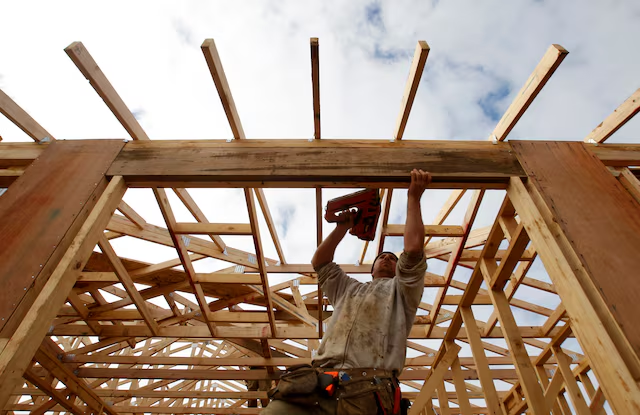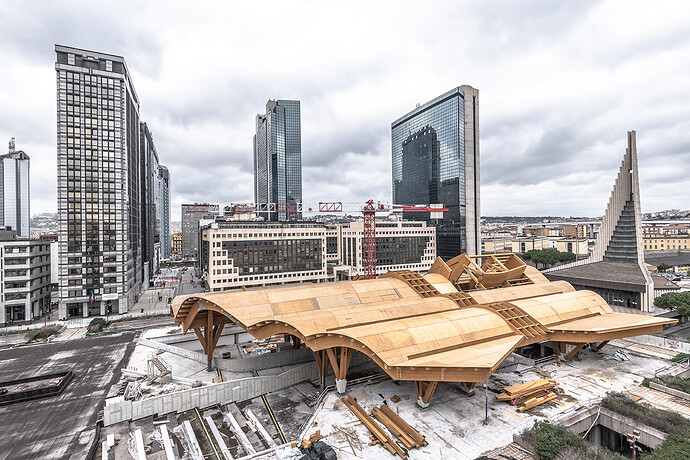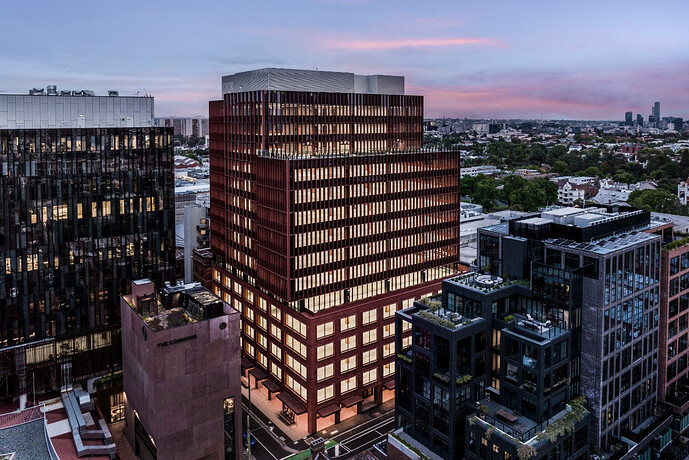
May 13 - A 5,000-seat football stadium, opens new tab in the UK, a replacement terminal at Zurich airport, the Naples central underground station, opens new tab and the aquatic centre for the Paris 2024 Olympic Games
, opens new tab have one thing in common: they are all using timber as the main construction material.
Timber is not a new building material – humans have built with wood throughout history. But the profile of timber buildings has increased, particularly in cities, as the need to decarbonise has intensified alongside the rise in so-called mass or engineered timber products. Broadly speaking, these are layers of wood bonded together with products including cross-laminated timber (CLT), “glulam”, and laminated veneer lumber.
Mass timber products can have several benefits over conventional building materials of concrete and steel. They are lightweight, scalable, strong and flexible and ideal for use in off-site construction techniques, which are faster to build, produce less waste, transport emissions and disruption in the wider area.
, opens new tab have revealed that using natural materials can reduce stress and improve concentration of building occupants, including one by the University of British Columbia
, opens new tab analysing the effects of using it in office interiors.
But the biggest impetus now is coming from cities’ drive to decarbonise. The built environment sector is responsible for 37% of worldwide emissions, according to a 2023 report
, opens new tabby the United Nations Environment Programme (UNEP), in large part because of high-emissions construction materials such as concrete and steel. Replacing these with mass timber could reduce global CO2 emissions by around 14-31%, and global fossil fuel use by 12-19%
Andrew Macpherson, executive director and head of asset development, Asia Pacific, at JLL, points out that the debate on how to slash this huge carbon footprint has typically focused on operational emissions, but the embodied carbon of building materials is now discussed and understood.
The Centro Direzionale di Napoli train station and subway designed by Barcelona-based studio Miralles Tagliabue - EMBT. Paolo Fassoli/Miralles Tagliabue/Handout via REUTERS Purchase Licensing Rights
“The main sources of embodied carbon in construction are concrete and steel, which form the structural frame. But from a sustainability perspective, timber would be a preferred choice because it is a renewable product,” he adds.
Built by Nature (BbN), a Netherlands-based network and grant-making fund trying to accelerate timber building in Europe, believes timber could become a cornerstone of the construction sector’s transition, and that its ability to directly substitute load-bearing structures, even in buildings up to 20 storeys, represents a paradigm shift.
However, uptake in the construction industry has been slowed by persistent myths about wood’s drawbacks
, opens new tab. These include concerns about strength and performance, environmental sustainability, availability of timber and cost.
Fire safety is, quite literally, the most burning issue for the industry. According to BbN, mass timber products are combustible, but behave very predictably in the case of fire, and many fire prevention measures can be taken in a timber building.
This has been a particular problem in the UK, where the 2017 Grenfell fire disaster, which killed 72 people in a social housing block in south London, has resulted in much stricter fire regulations banning the use of combustible materials in the external walls of buildings over 18 metres tall.
This led directly to a reduction in the residential market for mass timber buildings in the UK, according to Finbar Charleson, research lead of UK architectural firm dRMM Studio. However, timber has since become popular with its clients for sports facilities and schools, driven by the sustainability and wellbeing agendas. Post-COVID there has also been a lot of interest from the commercial sector, which increasingly wants buildings that stand out, he reports.
People attend a commemoration of the Grenfell Tower fire in London. In the wake of the 2017 fire, the UK introduced stricter regulations resulting in a reduction of mass timber construction. REUTERS/Henry Nicholls Purchase Licensing Rights
On the other hand, there are also some in the built environment sector who fear that greenwash about the benefits of wood products could undermine their potential. In a series of essays
, opens new tab, architects at UK-based Atelier Ten and U.S. group LEVER Architecture debunked myths they witnessed while working together on mass timber buildings in the United States.
Such claims include that wood construction products are inherently carbon-neutral and more sustainable than concrete, and that they absorb carbon emissions, rather than holding emissions previously sequestered by the trees they were made from.
In fact, the UNEP warns that the CO2 reduction potential of wood has been overestimated by proponents. Those carbon calculations depend on the sustainable replanting of trees, yet the rate of timber harvesting and deforestation in natural forests worldwide is faster than the overall growth of forests.
In tropical countries, around 10-30% of timber is harvested illegally, the UNEP said. But it’s a different story in the UK, for example, where most engineered wood products have been certified by either the Forest Stewardship Council (FSC) or the Programme for the Endorsement of Forest Certification (PEFC), a spokesperson for trade body Timber UK said.
Charleson, of dRMM Studio, says: “Although forest is a renewable and sustainable construction resource, that does not necessarily mean that they’re all made equal. Very large working forests can be pretty detrimental to biodiversity and might not necessarily be sequestering as much carbon as we would like,” he says.
His company is working with Edinburgh Napier University on analysis for the Forestry Commission in Britain on the benefits of using different tree species for construction. The team is producing new engineered wood products using a hybrid of hard and soft wood to reduce the reliance on Sitka spruce, currently the most commonly used species, according to the firm’s research lead.
A cyclist pedals past a stack of recently cut timber. The rate of timber harvesting and deforestation in natural forests worldwide is faster than the overall growth rate. REUTERS/Wolfgang Rattay Purchase Licensing Rights
Being able to use different tree species not only reduces risk of disease or climate change impacts reducing supply, but will also be better for biodiversity and carbon storage in forests.
“We’re really interested in questioning the norm and promoting more mixed uses, which in turn promotes more mixed woodlands,” he says.
In Denmark, the Danish Technological Institute (DTI) is coordinating the EU-funded Woodcircles project
, opens new tab, which aims to both find new ways to reuse wood from existing buildings at end of life, and to design future buildings with decommissioning for wood reuse in mind.
One barrier is that the glue used to construct engineered wood can affect its recyclability and degradability. According to Arup, biomass-based glues, including tannin, lignin, cellulose and plant proteins, could be a solution, but more research is needed to find out how they deal with moisture response, and their durability, strength and performance in fire.
Anders Kjellow, centre project manager for wood and biomaterials at the DTI, says barriers to wood construction vary from country to country. Sweden and Finland both have a tradition of building with wood, meaning that awareness and knowledge from all players within the value chain is high, but for others where large-scale wood construction is not the norm, it will take time for the whole industry to shift, he says.
“If a construction company wants to build with wood but doesn’t have the knowledge, it gets translated into a risk premium: we need to increase our knowledge to make sure that doesn’t happen,” he says.
Andrew Lawrence, global timber specialist at Arup, agrees: “Fire safety and water damage risks can increase the difficulty of getting insurance and lead to nervousness among clients and building control authorities.”
T3 Collingwood in Melbourne is the first timber office building in Australia. Hines/Handout via REUTERS Purchase Licensing Rights
Consensus on reliable solutions to these issues is needed across the sector, including guidance, regulation and education, he says.
Despite the slow progress overall, some cities have been driving forward policies to incentivise the use of mass timber. Amsterdam has mandated that 20% of buildings in the city must be made from mass timber, and Hamburg requires developers to assess the viability of using timber for every new construction project. It also subsidises every kilogram of wood used in the construction of non-residential buildings by 0.80 euros.
Outside Europe, Toronto has legislated to allow mass timber buildings up to 12 storeys, and the New York City Economic Development Corporation, and the city’s mayor, have launched a programme to raise awareness of the benefits of mass-timber construction, connect building industry professionals interested in the technique, and identify development opportunities throughout the city.
Some countries are using national-level policies to directly incentivise the use of timber, such as in Australia, which in 2022 launched a 300 million Australian dollar programme to encourage mass timber construction across the property sector, and France, where the government has legislated for all new public buildings to use at least 50% timber or other natural materials.
Others incentivise use of timber through policies on embodied carbon, including Germany, where a building subsidy programme is based on the entire lifecycle of the building, and Denmark, where all buildings larger than 1,000 square metres must calculate environmental impacts over 50 years.
Kjellow hopes that the use of timber will accelerate as policymakers and industry become more aware of the environmental advantages. “The construction industry has a gigantic environmental footprint, and one of the key contributors to lowering this is to use more wood,” he says.
Macpherson at JLL believes that demand will increasingly be driven by occupiers and end users of city buildings. “They will see it as brand enhancing, to help them attract and retain staff and accelerate their ESG journey,” he says.

